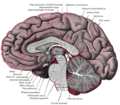Optic recess: Difference between revisions
CSV import |
CSV import |
||
| Line 24: | Line 24: | ||
{{stub}} | {{stub}} | ||
{{dictionary-stub1}} | {{dictionary-stub1}} | ||
<gallery> | |||
File:Gray721.png|Optic recess | |||
File:Gray720.png|Optic recess | |||
File:Gray736.png|Optic recess | |||
</gallery> | |||
Latest revision as of 01:53, 18 February 2025
Optic Recess is a structure found in the diencephalon, specifically in the third ventricle of the brain. It is a small indentation located at the front part of the third ventricle, and it is closely associated with the formation and development of the eye and optic nerve in vertebrates.
Anatomy[edit]
The optic recess is situated in the anterior part of the third ventricle, between the neural tube and the neural crest. It is a small indentation that is formed during the early stages of embryonic development. The optic recess is closely associated with the development of the eye and optic nerve in vertebrates.
Development[edit]
During embryonic development, the optic recess forms as a result of the invagination of the neural tube. This invagination leads to the formation of the optic vesicle, which eventually gives rise to the eye and optic nerve. The optic recess is therefore a crucial structure in the development of the visual system in vertebrates.
Function[edit]
The primary function of the optic recess is to facilitate the development of the eye and optic nerve. It serves as a point of connection between the neural tube and the developing optic vesicle. Through this connection, the optic recess allows for the transfer of signals and nutrients necessary for the development and maturation of the visual system.
Clinical Significance[edit]
Abnormalities in the formation of the optic recess can lead to various eye disorders and vision problems. For instance, malformations in the optic recess can result in coloboma, a condition characterized by missing pieces in the structures that form the eye. Other potential conditions include microphthalmia, where one or both eyes are abnormally small, and anophthalmia, a severe disorder where one or both eyes are completely absent.






